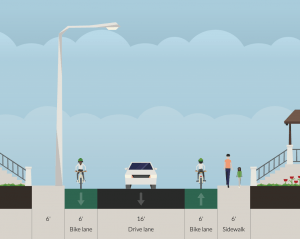
The UC Santa Cruz Coastal Science Campus is poorly connected to the main campus for those who bike. The most direct route, Western Dr, suffers from a lack of bicycle lanes, speeding vehicles, and “dooring” risk from parked cars. Not surprisingly, nearly 60% of current cyclists feel unsafe using this route.
This report, by Skye McIntyre Blomdal, Lucas Lee, Blake Pfister and Nadia Woodmansee, provides a detailed design to improve safety and encourage more people to travel by bicycle. Despite the physical constraints of a narrow right-of-way, the design would allow for continuous bicycle lanes on almost the entire corridor. To accomplish this, the report proposes innovative advisory bicycle lanes, which feature one shared driving lane for vehicles traveling in both directions, bordered by bicycle lanes on each side. Where the route widens out, parking-protected bicycle lanes are also recommended. A minimal number of parking spaces would need to be removed, and spaces are available on adjacent streets.
Read the full report, which was presented to the Santa Cruz Transportation and Public Works Commission on March 18, 2019.
